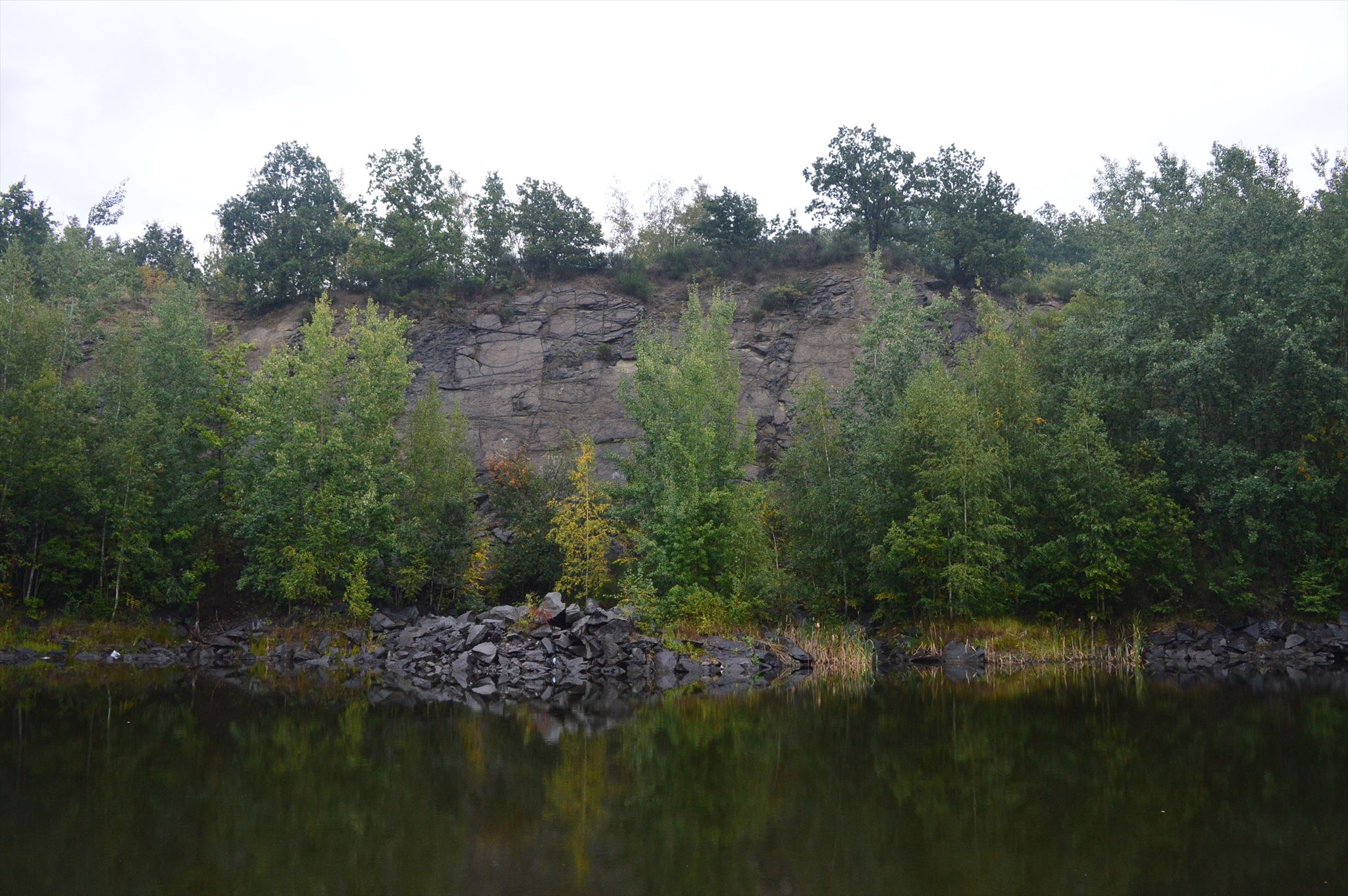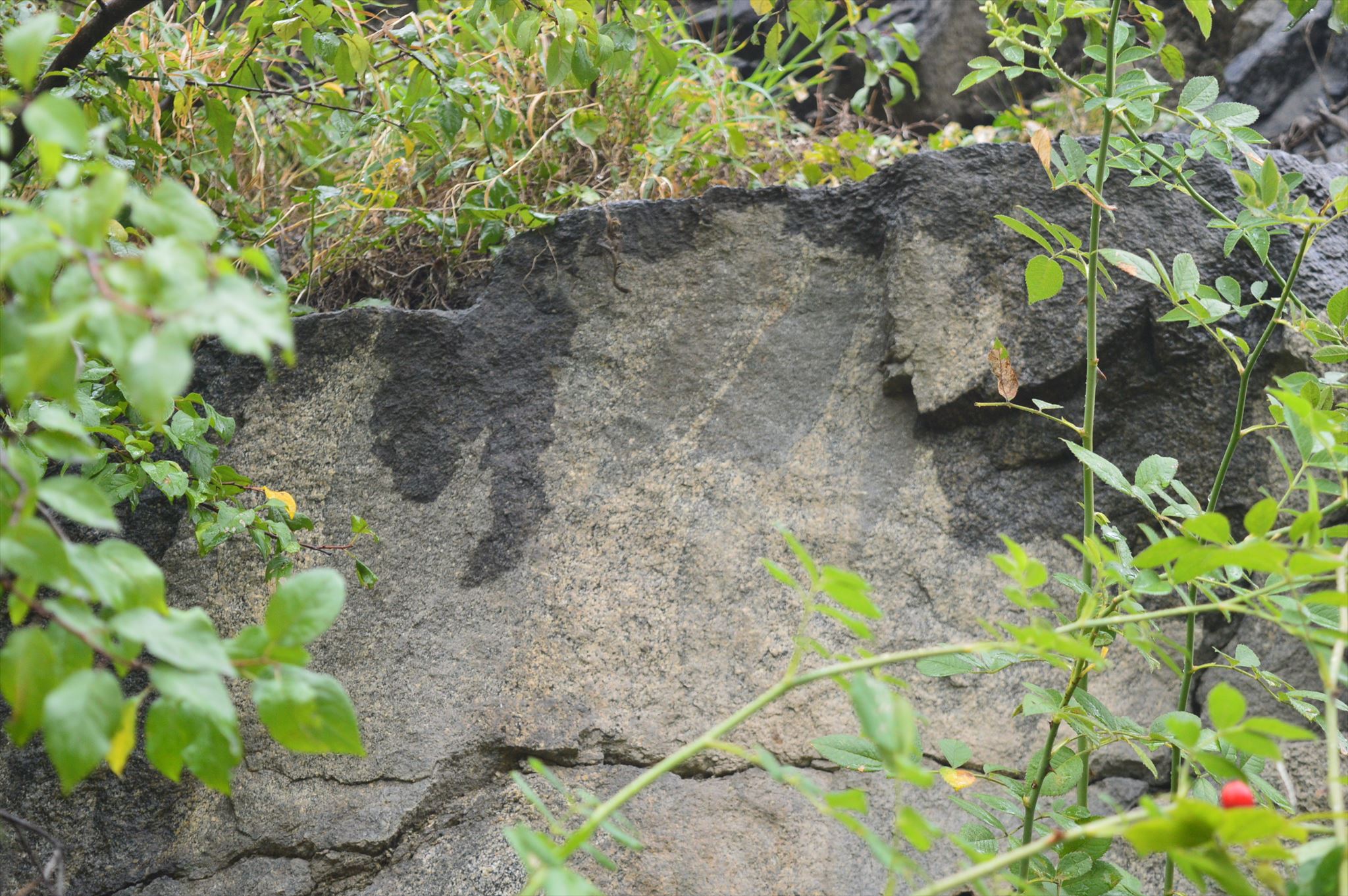
CIEMNY WIĘZIEŃ GRANODIORYTU
A DARK PRISONER OF GRANODIORITE

Niejednokrotnie, stworzone przez naturę więzienie spotyka się z zachwytem ludzi. Z podziwem spoglądamy na owada zatopionego w bursztynie, na zamarzniętego mamuta, a także na odcisk liścia pradawnej rośliny w kawałku skały. Należy pamiętać, że natura zamyka w więzieniach nie tylko organizmy żywe.
Skały i minerały w swoim wnętrzu zamykają inne skały i minerały. Podczas wypływu magmy na powierzchnię ziemi niejednokrotnie lawa porywa z sobą skały podłoża, by następnie zamknąć je w czasie zastygania. Wydobywająca się z głębi Ziemi magma może również porwać fragment skał z górnego płaszcza (mówimy wtedy o ksenolitach). Zdarza się także, że krystalizujący minerał zamknie w swoim wnętrzu istniejący już wcześniej minerał. Wszystkie te sytuacje są niezwykle interesujące dla badaczy i stają się często tematem ich dociekań. Przynoszą one bowiem istotne informacje m.in. na temat skał z głębi Ziemi.
W magmowych skałach głębinowych występują enklawy. Enklawa to fragment skały oderwany przez intrudującą (wdzierającą się w inne skały, ale pod powierzchnią ziemi) magmę od ścian i/lub stropu zbiornika magmowego lub fragment zakrzepłej wcześniej partii tej samej magmy, zamknięty w skale magmowej.
Tak, nie mylisz się. Zabraliśmy Cię do tego kamieniołomu granodiorytu (fig 1.), aby pokazać Ci jedną skałę zamkniętą w drugiej. Na północno-wschodniej ścianie kamieniołomu możesz obserwować elipsoidalne, ciemne enklawy (zbudowane głównie z amfiboli) zamknięte w zdecydowanie jaśniejszym granodiorycie (fig. 2). Skały kontaktują ze sobą niezbyt ostro, ale na pewno zobaczysz granicę między nimi.
Fig. 1. Widok ogólny kamieniołomu. Fot. Magdalena Furca

Fig. 2. Ciemne enklawy w granodiorycie. Fot. Magdalena Furca

Prawdziwy miłośnik nauk o Ziemi, patrząc na to fascynujące odsłonięcie na pewno zada sobie pytanie: „Skąd się wzięły te enklawy?” W tajemnicy powiem Ci, że ktoś przed Tobą już zadał sobie to pytanie i wykonał badania. Udało się ustalić, że enklawy w tym kamieniołomie (znaleźć je można również w innych miejscach wyrobiska) stanowią pozostałość po amfibolitach (występują one w otoczeniu granodiorytów) znajdujących się w serii skalnej, z której wytapiała się magma granodiorytowa. Amfibolity trafiły do magmy, nie stopiły się w całości (topienie amfiboli następuje w wyższej temperaturze niż tej, którą miała magma granodiorytowa) i tym samym nie wymieszały się z magmą. Pozostały w później zastygniętej skale jak rodzynki w serniku. Część enklaw, w późniejszym etapie, została jednak zinfiltrowana przez magmę, przez co trochę zmienił się ich skład. Tym samym w obrębie jednego kamieniołomu można spotkać enklawy o różnym składzie mineralnym oraz w różny sposób kontaktujące się z granodiorytem.
Oprócz opisanych tu skał w kamieniołomie można się jeszcze natknąć na co najmniej cztery rodzaje skał. Pospaceruj chwilę i sprawdź, jakie jeszcze uda Ci się znaleźć skały.
Aby zalogować EC musisz odwiedzić miejsce i przesłać odpowiedzi na pytania:
- Opisz co najmniej dwie odmiany skał, które możesz znaleźć w terenie. Uwzględnij np. ich ogólną barwę, wielkość i kolor elementów (minerałów) je budujących (jeżeli są dostrzegalne gołym okiem), wskaż, jeżeli któreś składniki dominują w skale. Dołącz zdjęcie opisywanych odmian skał.
- Podaj definicję terminu enklawa
- Dlaczego amfibole stanowiące główny składnik ciemnych enklaw nie zostały stopione w magmie granodiorytowej, której temperatura wynosiła ok. 850°C?
UWAGA! Do zalogowania tej skrytki EarthCache wymagane jest wysłanie odpowiedzi do zadań przez profil PIG_PIB. Logować można po wysłaniu rozwiązań, nie czekając na wiadomość z naszej strony. Logi bez wysłanych odpowiedzi będą kasowane w ciągu 14 dni.

Often times, a prison created by nature meets people's admiration. We look at an insect embedded in amber, at a frozen mammoth, and at the imprint of an ancient plant leaf in a piece of rock. It should be remembered that nature traps not only living organisms in such beoutiful prisons.
Rocks and minerals enclose other rocks and minerals inside. During the flow of magma to the surface of the earth, the lava often carries away the bedrocks and then closes them during congelation. The magma that comes out from the depths of the Earth can also grab a fragment of rock from the upper mantle (we are then talking about xenoliths). It also happens that a crystallizing mineral will lock an already existing mineral inside. All these situations are extremely interesting for researchers and often become the subject of their analyzes. They bring important information about rocks from the depths of the Earth.
There are enclaves in igneous rocks. An enclave is a fragment of a rock torn off by magma intruding (penetrating into other rocks, but below the ground) from the walls and/or the top of a magma reservoir or a fragment of a previously solidified part of the same magma, enclosed in an igneous rock.
Yes, you're right. We took you to this granodiorite quarry (fig 1.) to show you one rock enclosed in another. On the north-eastern wall of the quarry you can observe ellipsoidal, dark enclaves (mainly made of amphiboles) enclosed in a much lighter granodiorite (fig. 2). The rocks have not sharp contact with each other, but you will surely see the boundary between them.
A true lover of Earth sciences, looking at this fascinating outcrop, will surely ask himself: "Where did these enclaves come from?" I will tell you in secret that someone before you has already asked this question and has done some research. It was possible to establish that the enclaves in this quarry (they can also be found in other places of the excavation) are the remains of amphibolites (they are surrounded by granodiorites) from the rock series from which granodiorite magma was melted. The amphibolites found their way into the magma, did not fully melt (amphibole melting occurs at a higher temperature than that of the granodioritic magma) and thus did not mix with the magma. They remained in the later solidified rock like raisins in a cheesecake. Some of the enclaves, however, were infiltrated by magma at a later stage, which changed their composition a bit. Thus, within one quarry, one can find enclaves with a different mineral composition and contact with the granodiorite in various ways.
In addition to the rocks described here, at least four types of rock can be found in the quarry. Walk for a while and check what other rocks you can find.
To log the EC you need to visit the place and send answers to the questions:
- Describe at least two types of rock that you can find in the quarry. Take into account, for example, their general colour, size and colour of the elements (minerals) that build them (if they are visible to the naked eye), indicate if any components dominate in the rock. Attach a photo of the described rock types.
- Give a definition of the term enclave.
- Why were the amphiboles, which are the main component of dark enclaves, not melted in granodioritic magma, the temperature of which was about 850°C?
WARNING! To log this EC you have to send the answers to PIG_PIB profile. You can log after sending the answers, without waiting for our reply. Logs without answers will be deleted within 14 days!
Literatura / References:
- Mizerski W., Sylwestrzak H. 2002. Słownik geologiczny. Wydawnictwo Naukowe PWN. Warszawa
- Puziewicz J. 1992. Geneza granodiorytu z Koźmic (strefa Niemczy, Dolny Śląsk). Archiwum Mineralogiczne 47, Z. 2, 95-146.
Grafika w tle / Background graphics: Pixabay.com

